Managing People and Organizations: Communication Skills Essay
VerifiedAdded on 2022/09/17
|5
|1373
|21
Essay
AI Summary
This essay delves into the crucial role of communication skills in contemporary organizational management. It highlights how effective communication is essential for implementing strategies and achieving organizational goals in the digital era. The essay emphasizes the importance of written, verbal/oral, proxemics, and kinesics in fostering successful strategy execution. It explores how communication serves as a vehicle and a means for achieving strategic objectives, providing the necessary information for decision-making and fostering employee understanding. The discussion also addresses potential barriers to effective communication, such as diverse perceptions and information overload, and emphasizes the need to manage and overcome these challenges. The essay concludes by asserting that effective communication is the lifeblood of any organization, directly impacting productivity, employee relations, and overall success. References from various academic sources are provided to support the arguments presented.
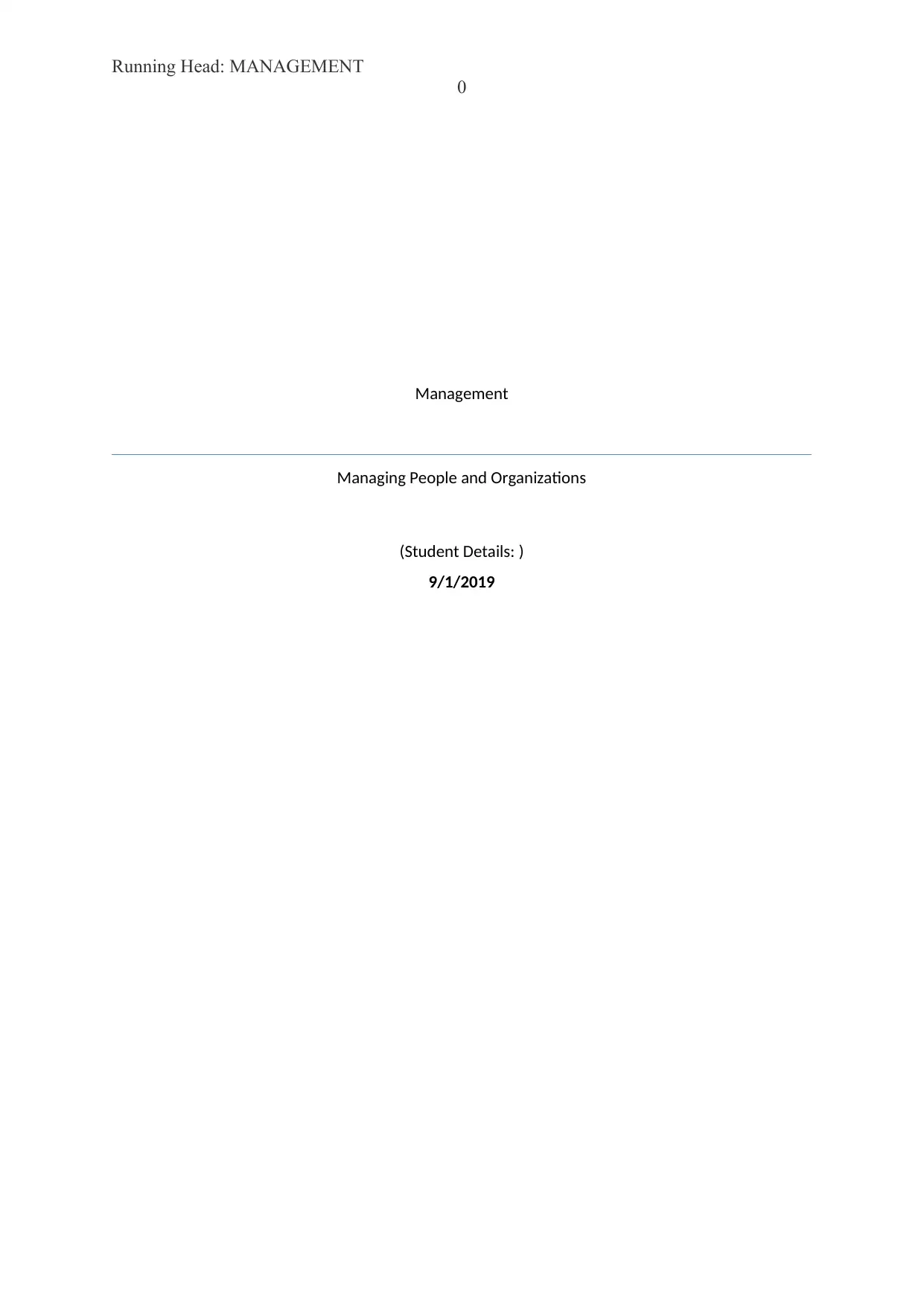
Running Head: MANAGEMENT
0
Management
Managing People and Organizations
(Student Details: )
9/1/2019
0
Management
Managing People and Organizations
(Student Details: )
9/1/2019
Paraphrase This Document
Need a fresh take? Get an instant paraphrase of this document with our AI Paraphraser
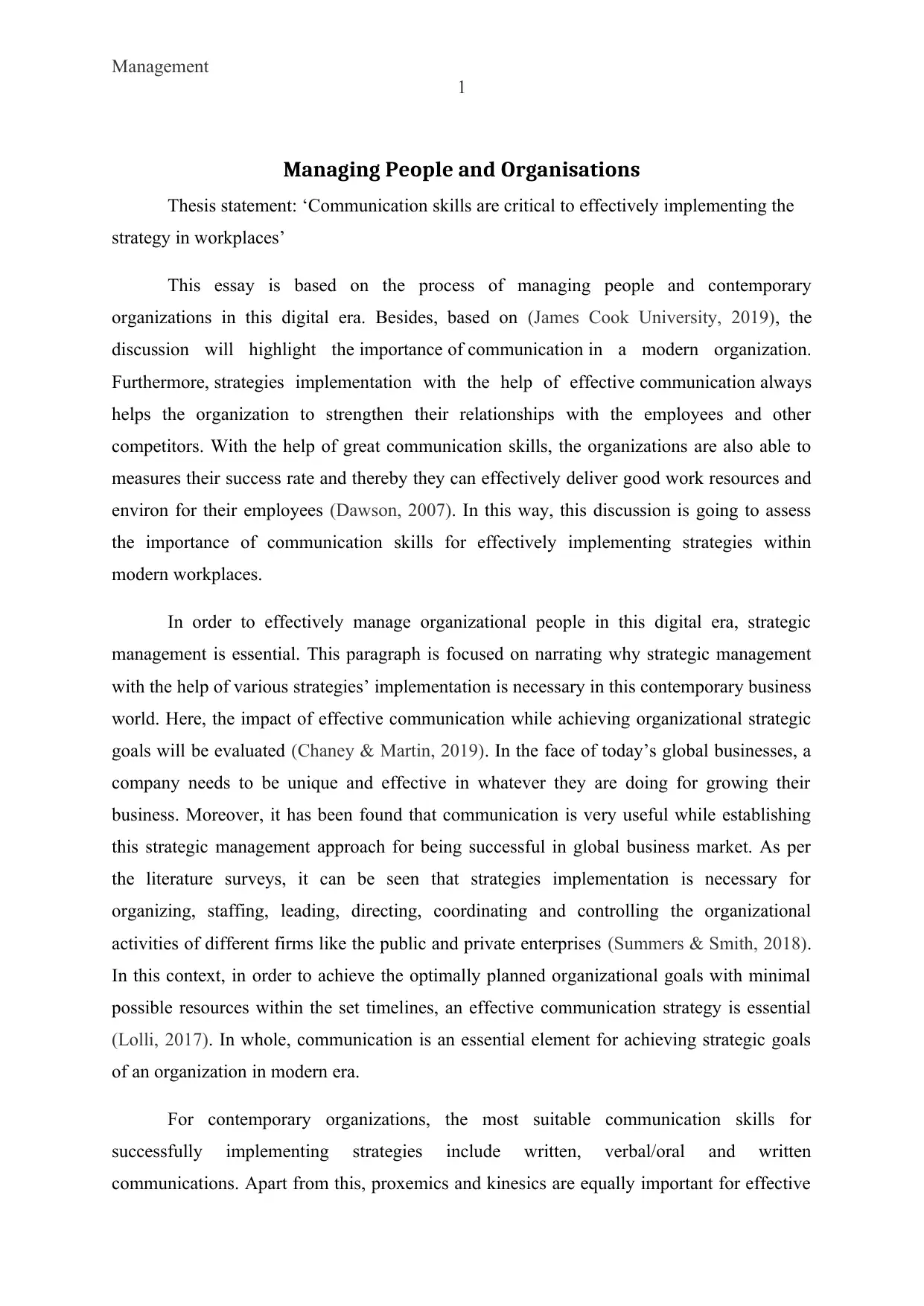
Management
1
Managing People and Organisations
Thesis statement: ‘Communication skills are critical to effectively implementing the
strategy in workplaces’
This essay is based on the process of managing people and contemporary
organizations in this digital era. Besides, based on (James Cook University, 2019), the
discussion will highlight the importance of communication in a modern organization.
Furthermore, strategies implementation with the help of effective communication always
helps the organization to strengthen their relationships with the employees and other
competitors. With the help of great communication skills, the organizations are also able to
measures their success rate and thereby they can effectively deliver good work resources and
environ for their employees (Dawson, 2007). In this way, this discussion is going to assess
the importance of communication skills for effectively implementing strategies within
modern workplaces.
In order to effectively manage organizational people in this digital era, strategic
management is essential. This paragraph is focused on narrating why strategic management
with the help of various strategies’ implementation is necessary in this contemporary business
world. Here, the impact of effective communication while achieving organizational strategic
goals will be evaluated (Chaney & Martin, 2019). In the face of today’s global businesses, a
company needs to be unique and effective in whatever they are doing for growing their
business. Moreover, it has been found that communication is very useful while establishing
this strategic management approach for being successful in global business market. As per
the literature surveys, it can be seen that strategies implementation is necessary for
organizing, staffing, leading, directing, coordinating and controlling the organizational
activities of different firms like the public and private enterprises (Summers & Smith, 2018).
In this context, in order to achieve the optimally planned organizational goals with minimal
possible resources within the set timelines, an effective communication strategy is essential
(Lolli, 2017). In whole, communication is an essential element for achieving strategic goals
of an organization in modern era.
For contemporary organizations, the most suitable communication skills for
successfully implementing strategies include written, verbal/oral and written
communications. Apart from this, proxemics and kinesics are equally important for effective
1
Managing People and Organisations
Thesis statement: ‘Communication skills are critical to effectively implementing the
strategy in workplaces’
This essay is based on the process of managing people and contemporary
organizations in this digital era. Besides, based on (James Cook University, 2019), the
discussion will highlight the importance of communication in a modern organization.
Furthermore, strategies implementation with the help of effective communication always
helps the organization to strengthen their relationships with the employees and other
competitors. With the help of great communication skills, the organizations are also able to
measures their success rate and thereby they can effectively deliver good work resources and
environ for their employees (Dawson, 2007). In this way, this discussion is going to assess
the importance of communication skills for effectively implementing strategies within
modern workplaces.
In order to effectively manage organizational people in this digital era, strategic
management is essential. This paragraph is focused on narrating why strategic management
with the help of various strategies’ implementation is necessary in this contemporary business
world. Here, the impact of effective communication while achieving organizational strategic
goals will be evaluated (Chaney & Martin, 2019). In the face of today’s global businesses, a
company needs to be unique and effective in whatever they are doing for growing their
business. Moreover, it has been found that communication is very useful while establishing
this strategic management approach for being successful in global business market. As per
the literature surveys, it can be seen that strategies implementation is necessary for
organizing, staffing, leading, directing, coordinating and controlling the organizational
activities of different firms like the public and private enterprises (Summers & Smith, 2018).
In this context, in order to achieve the optimally planned organizational goals with minimal
possible resources within the set timelines, an effective communication strategy is essential
(Lolli, 2017). In whole, communication is an essential element for achieving strategic goals
of an organization in modern era.
For contemporary organizations, the most suitable communication skills for
successfully implementing strategies include written, verbal/oral and written
communications. Apart from this, proxemics and kinesics are equally important for effective
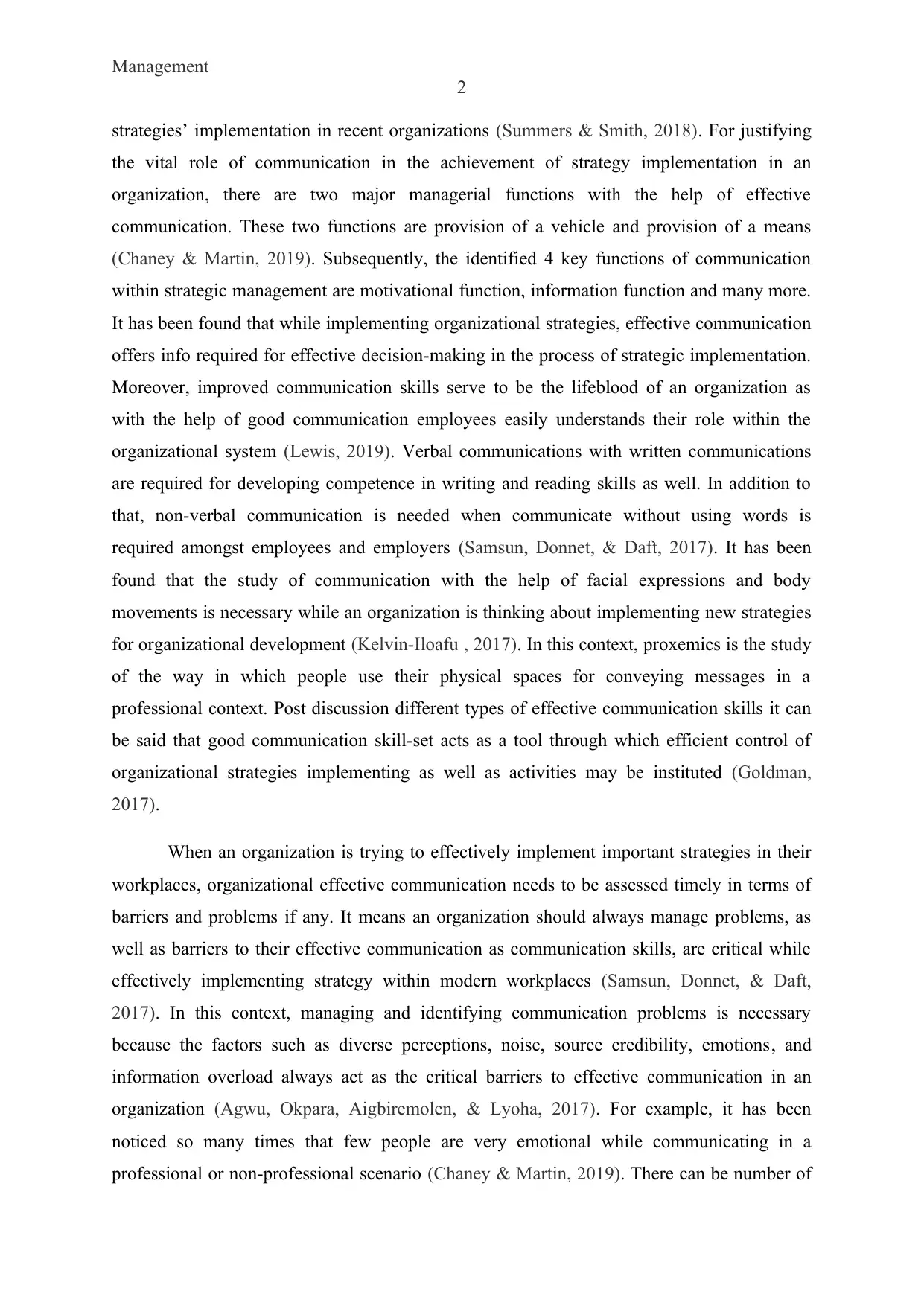
Management
2
strategies’ implementation in recent organizations (Summers & Smith, 2018). For justifying
the vital role of communication in the achievement of strategy implementation in an
organization, there are two major managerial functions with the help of effective
communication. These two functions are provision of a vehicle and provision of a means
(Chaney & Martin, 2019). Subsequently, the identified 4 key functions of communication
within strategic management are motivational function, information function and many more.
It has been found that while implementing organizational strategies, effective communication
offers info required for effective decision-making in the process of strategic implementation.
Moreover, improved communication skills serve to be the lifeblood of an organization as
with the help of good communication employees easily understands their role within the
organizational system (Lewis, 2019). Verbal communications with written communications
are required for developing competence in writing and reading skills as well. In addition to
that, non-verbal communication is needed when communicate without using words is
required amongst employees and employers (Samsun, Donnet, & Daft, 2017). It has been
found that the study of communication with the help of facial expressions and body
movements is necessary while an organization is thinking about implementing new strategies
for organizational development (Kelvin-Iloafu , 2017). In this context, proxemics is the study
of the way in which people use their physical spaces for conveying messages in a
professional context. Post discussion different types of effective communication skills it can
be said that good communication skill-set acts as a tool through which efficient control of
organizational strategies implementing as well as activities may be instituted (Goldman,
2017).
When an organization is trying to effectively implement important strategies in their
workplaces, organizational effective communication needs to be assessed timely in terms of
barriers and problems if any. It means an organization should always manage problems, as
well as barriers to their effective communication as communication skills, are critical while
effectively implementing strategy within modern workplaces (Samsun, Donnet, & Daft,
2017). In this context, managing and identifying communication problems is necessary
because the factors such as diverse perceptions, noise, source credibility, emotions, and
information overload always act as the critical barriers to effective communication in an
organization (Agwu, Okpara, Aigbiremolen, & Lyoha, 2017). For example, it has been
noticed so many times that few people are very emotional while communicating in a
professional or non-professional scenario (Chaney & Martin, 2019). There can be number of
2
strategies’ implementation in recent organizations (Summers & Smith, 2018). For justifying
the vital role of communication in the achievement of strategy implementation in an
organization, there are two major managerial functions with the help of effective
communication. These two functions are provision of a vehicle and provision of a means
(Chaney & Martin, 2019). Subsequently, the identified 4 key functions of communication
within strategic management are motivational function, information function and many more.
It has been found that while implementing organizational strategies, effective communication
offers info required for effective decision-making in the process of strategic implementation.
Moreover, improved communication skills serve to be the lifeblood of an organization as
with the help of good communication employees easily understands their role within the
organizational system (Lewis, 2019). Verbal communications with written communications
are required for developing competence in writing and reading skills as well. In addition to
that, non-verbal communication is needed when communicate without using words is
required amongst employees and employers (Samsun, Donnet, & Daft, 2017). It has been
found that the study of communication with the help of facial expressions and body
movements is necessary while an organization is thinking about implementing new strategies
for organizational development (Kelvin-Iloafu , 2017). In this context, proxemics is the study
of the way in which people use their physical spaces for conveying messages in a
professional context. Post discussion different types of effective communication skills it can
be said that good communication skill-set acts as a tool through which efficient control of
organizational strategies implementing as well as activities may be instituted (Goldman,
2017).
When an organization is trying to effectively implement important strategies in their
workplaces, organizational effective communication needs to be assessed timely in terms of
barriers and problems if any. It means an organization should always manage problems, as
well as barriers to their effective communication as communication skills, are critical while
effectively implementing strategy within modern workplaces (Samsun, Donnet, & Daft,
2017). In this context, managing and identifying communication problems is necessary
because the factors such as diverse perceptions, noise, source credibility, emotions, and
information overload always act as the critical barriers to effective communication in an
organization (Agwu, Okpara, Aigbiremolen, & Lyoha, 2017). For example, it has been
noticed so many times that few people are very emotional while communicating in a
professional or non-professional scenario (Chaney & Martin, 2019). There can be number of
⊘ This is a preview!⊘
Do you want full access?
Subscribe today to unlock all pages.

Trusted by 1+ million students worldwide
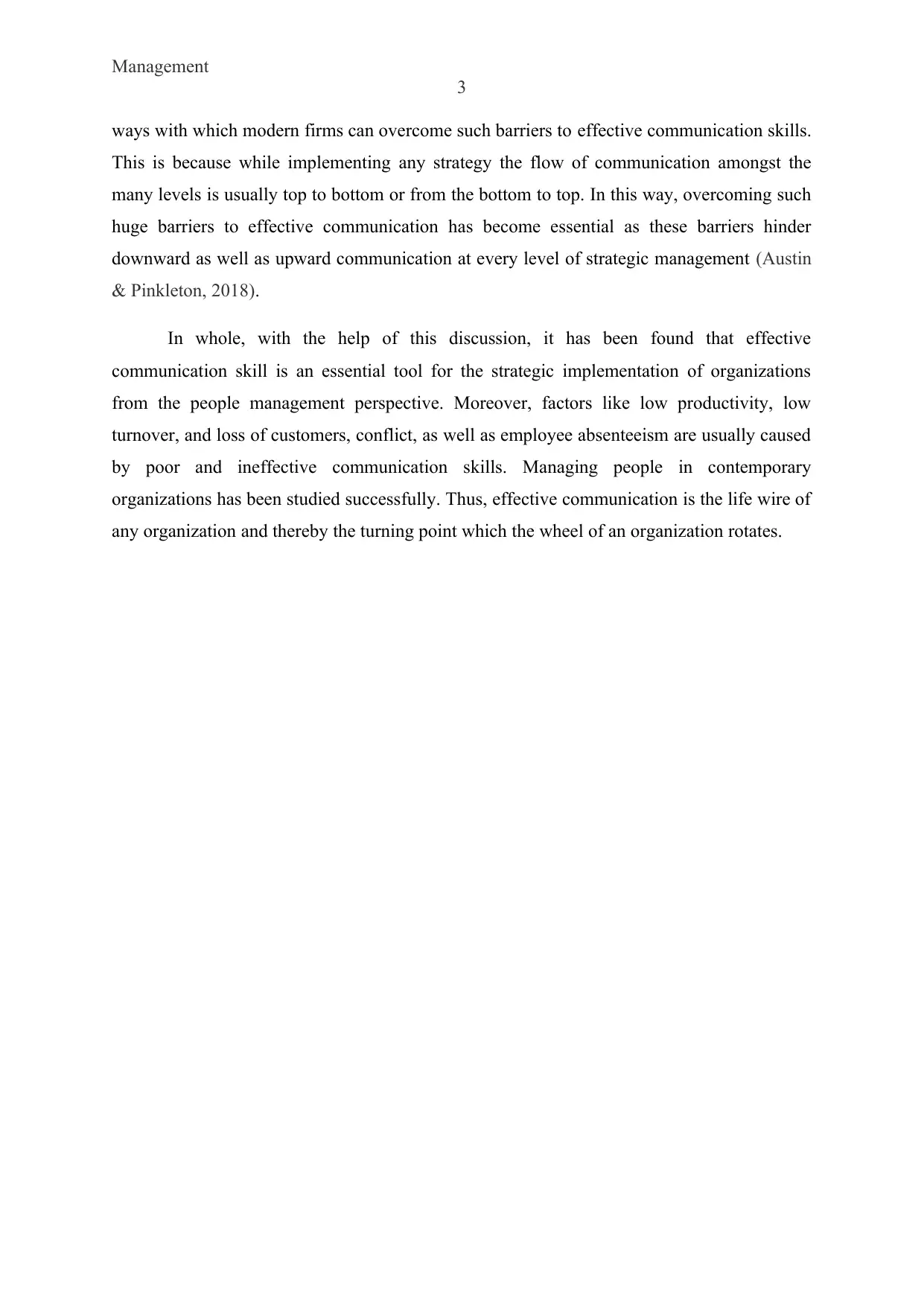
Management
3
ways with which modern firms can overcome such barriers to effective communication skills.
This is because while implementing any strategy the flow of communication amongst the
many levels is usually top to bottom or from the bottom to top. In this way, overcoming such
huge barriers to effective communication has become essential as these barriers hinder
downward as well as upward communication at every level of strategic management (Austin
& Pinkleton, 2018).
In whole, with the help of this discussion, it has been found that effective
communication skill is an essential tool for the strategic implementation of organizations
from the people management perspective. Moreover, factors like low productivity, low
turnover, and loss of customers, conflict, as well as employee absenteeism are usually caused
by poor and ineffective communication skills. Managing people in contemporary
organizations has been studied successfully. Thus, effective communication is the life wire of
any organization and thereby the turning point which the wheel of an organization rotates.
3
ways with which modern firms can overcome such barriers to effective communication skills.
This is because while implementing any strategy the flow of communication amongst the
many levels is usually top to bottom or from the bottom to top. In this way, overcoming such
huge barriers to effective communication has become essential as these barriers hinder
downward as well as upward communication at every level of strategic management (Austin
& Pinkleton, 2018).
In whole, with the help of this discussion, it has been found that effective
communication skill is an essential tool for the strategic implementation of organizations
from the people management perspective. Moreover, factors like low productivity, low
turnover, and loss of customers, conflict, as well as employee absenteeism are usually caused
by poor and ineffective communication skills. Managing people in contemporary
organizations has been studied successfully. Thus, effective communication is the life wire of
any organization and thereby the turning point which the wheel of an organization rotates.
Paraphrase This Document
Need a fresh take? Get an instant paraphrase of this document with our AI Paraphraser
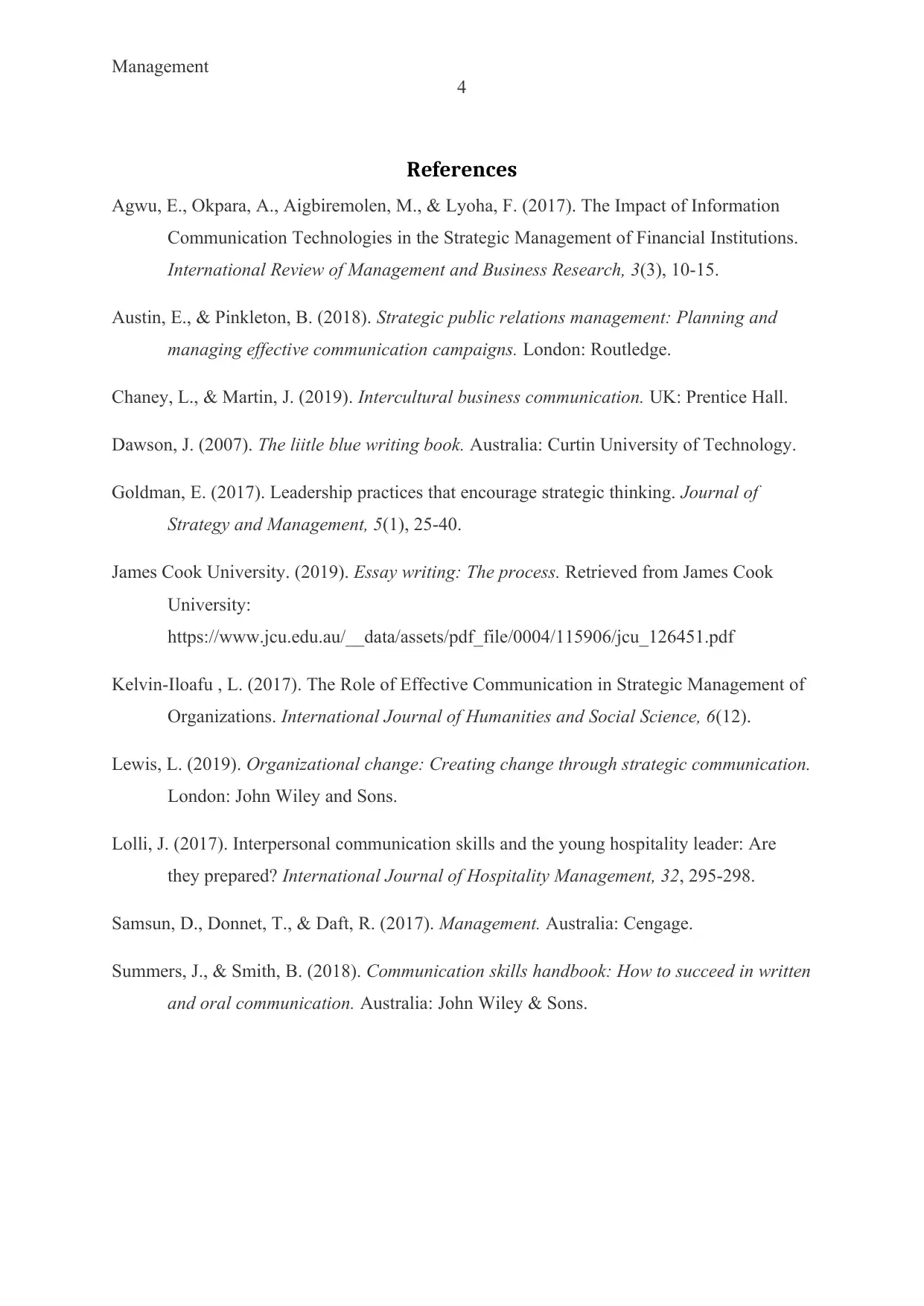
Management
4
References
Agwu, E., Okpara, A., Aigbiremolen, M., & Lyoha, F. (2017). The Impact of Information
Communication Technologies in the Strategic Management of Financial Institutions.
International Review of Management and Business Research, 3(3), 10-15.
Austin, E., & Pinkleton, B. (2018). Strategic public relations management: Planning and
managing effective communication campaigns. London: Routledge.
Chaney, L., & Martin, J. (2019). Intercultural business communication. UK: Prentice Hall.
Dawson, J. (2007). The liitle blue writing book. Australia: Curtin University of Technology.
Goldman, E. (2017). Leadership practices that encourage strategic thinking. Journal of
Strategy and Management, 5(1), 25-40.
James Cook University. (2019). Essay writing: The process. Retrieved from James Cook
University:
https://www.jcu.edu.au/__data/assets/pdf_file/0004/115906/jcu_126451.pdf
Kelvin-Iloafu , L. (2017). The Role of Effective Communication in Strategic Management of
Organizations. International Journal of Humanities and Social Science, 6(12).
Lewis, L. (2019). Organizational change: Creating change through strategic communication.
London: John Wiley and Sons.
Lolli, J. (2017). Interpersonal communication skills and the young hospitality leader: Are
they prepared? International Journal of Hospitality Management, 32, 295-298.
Samsun, D., Donnet, T., & Daft, R. (2017). Management. Australia: Cengage.
Summers, J., & Smith, B. (2018). Communication skills handbook: How to succeed in written
and oral communication. Australia: John Wiley & Sons.
4
References
Agwu, E., Okpara, A., Aigbiremolen, M., & Lyoha, F. (2017). The Impact of Information
Communication Technologies in the Strategic Management of Financial Institutions.
International Review of Management and Business Research, 3(3), 10-15.
Austin, E., & Pinkleton, B. (2018). Strategic public relations management: Planning and
managing effective communication campaigns. London: Routledge.
Chaney, L., & Martin, J. (2019). Intercultural business communication. UK: Prentice Hall.
Dawson, J. (2007). The liitle blue writing book. Australia: Curtin University of Technology.
Goldman, E. (2017). Leadership practices that encourage strategic thinking. Journal of
Strategy and Management, 5(1), 25-40.
James Cook University. (2019). Essay writing: The process. Retrieved from James Cook
University:
https://www.jcu.edu.au/__data/assets/pdf_file/0004/115906/jcu_126451.pdf
Kelvin-Iloafu , L. (2017). The Role of Effective Communication in Strategic Management of
Organizations. International Journal of Humanities and Social Science, 6(12).
Lewis, L. (2019). Organizational change: Creating change through strategic communication.
London: John Wiley and Sons.
Lolli, J. (2017). Interpersonal communication skills and the young hospitality leader: Are
they prepared? International Journal of Hospitality Management, 32, 295-298.
Samsun, D., Donnet, T., & Daft, R. (2017). Management. Australia: Cengage.
Summers, J., & Smith, B. (2018). Communication skills handbook: How to succeed in written
and oral communication. Australia: John Wiley & Sons.
1 out of 5
Related Documents
Your All-in-One AI-Powered Toolkit for Academic Success.
+13062052269
info@desklib.com
Available 24*7 on WhatsApp / Email
![[object Object]](/_next/static/media/star-bottom.7253800d.svg)
Unlock your academic potential
Copyright © 2020–2025 A2Z Services. All Rights Reserved. Developed and managed by ZUCOL.





